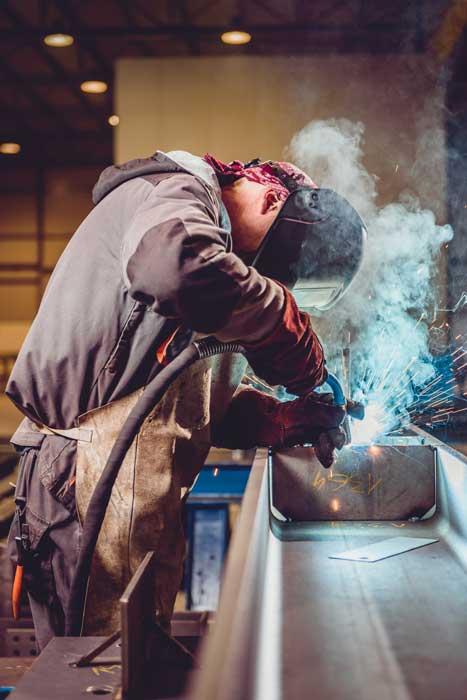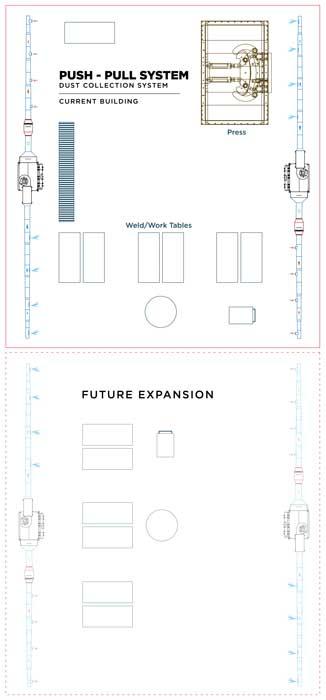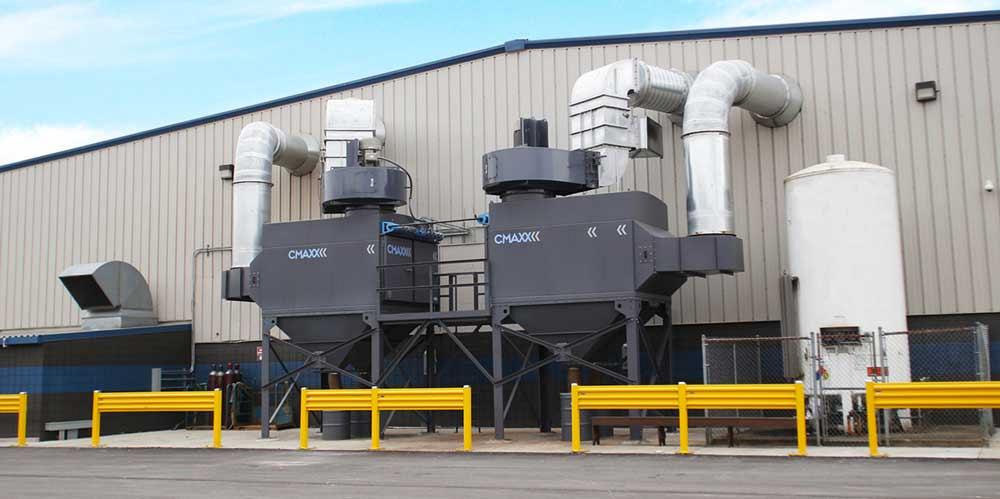President/CEO
- FMA
- The Fabricator
- FABTECH
- Canadian Metalworking
Categories
- Additive Manufacturing
- Aluminum Welding
- Arc Welding
- Assembly and Joining
- Automation and Robotics
- Bending and Forming
- Consumables
- Cutting and Weld Prep
- Electric Vehicles
- En Español
- Finishing
- Hydroforming
- Laser Cutting
- Laser Welding
- Machining
- Manufacturing Software
- Materials Handling
- Metals/Materials
- Oxyfuel Cutting
- Plasma Cutting
- Power Tools
- Punching and Other Holemaking
- Roll Forming
- Safety
- Sawing
- Shearing
- Shop Management
- Testing and Measuring
- Tube and Pipe Fabrication
- Tube and Pipe Production
- Waterjet Cutting
Industry Directory
Webcasts
Podcasts
FAB 40
Advertise
Subscribe
Account Login
Search
How an ambient dust, fume collection system works
With no ductwork or localized capture required, such a system could make sense for metal fabricators
- By Jeremiah Wann
- October 30, 2017
- Article
- Safety

Figure 1
For some fabricating environments, localized fume and dust collection is not
an attractive option. That’s when it might make sense to install an ambient air system.
Any metal fabricator that has been involved in discussions about weld dust and fume management knows about ambient systems. However, a majority of those who work on a shop floor probably don’t have any idea about how these systems work.
At the most basic level, it is a type of dust and fume collection system (see Figure 1). Because cartridge collectors are efficient and have a small footprint, they often are recommended for ambient systems. Cartridge collectors use densely pleated filter cartridges with a very high surface area, so they can handle a lot of airflow. They are also very efficient, up to MERV 16, making them suitable for even very fine fumes. With a cartridge collector, even very small particulate is handled efficiently.
An ambient dust collection system consistently exchanges all of the air in the building or a section of the building. On the other end of this spectrum is a source-capture system, in which all the dust or fume collection is done with weld arms, fume hoods, or other points of capture.
A metal fabricator installing an ambient system in a shop will enjoy some advantages when compared to more localized approaches to dust and fume management. An ambient system is efficient. Running enough airflow to keep fumes moving at several capture points, such as a hood over a welding cell, requires a large fan and a lot of ductwork and power. An ambient system requires very little ductwork, so air doesn’t have to be moved through a maze of ducts. Instead, the collector removes dirty air from the entire work area and then returns it as clean, filtered air (see Figure 2). It’s possible with an ambient system to create a push/pull operation that pulls dirty air out on one side and blows clean air back in on the other side. This keeps the overall air in the plant cleaner, since even fugitive dust or fumes from portable sources are managed.
Why a Modular Ambient System?
A modular ambient dust collection system uses multiple, smaller collectors instead of one large one. This type of system is not suitable for every situation. For most facilities with consistent production and a large manufacturing space, a single central system is usually the right choice, as there is only one machine to maintain and it can run consistently.
Consistency, however, is not the hallmark of most manufacturing environments. A company may have big seasonal fluctuations in production levels, or a job shop could see manufacturing activity change with the coming and going of jobs.
In environments where production is variable, two or more small systems instead of one large ambient system may make sense. This allows a manufacturer to take one of the systems offline during low-production times while still running the rest of the system. Such an approach can reduce energy costs during low-production times.
For companies with plans for expansion, a big system for the whole space might be a big hit to the budget. The option to start with smaller systems and add on as the company expands may be easier on the budget and help with planning for the future.
For companies planning to start using their whole space immediately, a single, large system is usually the recommended option. The choice between one large system and a modular system often comes down to the issues of current and future use of space, along with current and future budgets.
What Does “Push/Pull” Mean in an Ambient System?
When dust and fume collection specialists talk about a “push/pull” system, they mean that the system pulls dirty, unfiltered air out of the building; runs it through a dust collector; and pushes clean air back in. This is an efficient way of making sure all the air in the area gets exchanged consistently and is always clean.

Figure 2
This push/pull system can accommodate a typical fabrication shop with welding areas, presses, cutting tables, and other dust and fume generators. Localized source capture near those dust- and fume-producing areas is not required.
Why is push/pull better than just pulling the dirty air out? If dirty air is simply removed and run through the filters, it has to go somewhere. If dirty air is vented outside, the system is cleaning the air, but the whole process is wasteful. Companies can achieve significant energy savings by pushing the clean air back into the facility after it is filtered (see Figure 3). They take advantage of heating or cooling capabilities that wouldn’t exist if the dirty air were vented outside.
A push/pull system also creates air movement in the facility. When dirty air is pulled out and not pushed back in, the manufacturing facility suffers from stagnant air and limited airflow. Dirty air gets sucked in near the vents or ducts, but there is no air movement to push the dirty air from the rest of the area toward the vents.
Such a stagnant environment also caters to the creation of negative indoor air pressure. Evidence of such an environment are exterior doors that are difficult to open and close and odors such as lift truck exhaust that linger. Negative indoor air pressure also allows carbon monoxide or other dangerous gases to build up.
The facility should always maintain the same overall pressure as the ambient air (unless it’s designed otherwise). With a push/pull system, airflow in and out maintains consistent ambient pressure, and a negative air pressure situation is avoided. Without a push/pull system, a metal fabricator may have to purchase additional air makeup HVAC units to pull in outside air to prevent developing negative pressure in the building.
A Beneficial Bottom Line
A modular ambient system provides the flexibility that many metal manufacturers are looking for. A large central ambient air system is more efficient and requires less maintenance than a modular system, but the large system simply may be too expensive for some companies or too much for a manufacturer with a lot of production variation in its operations.
With either type of ambient air system, the push/pull approach keeps the air very clean and prevents dust from accumulating anywhere in the facility. It creates a clean and safe working environment, which is helpful in boosting productivity and employee morale.
About the Author
subscribe now

The Fabricator is North America's leading magazine for the metal forming and fabricating industry. The magazine delivers the news, technical articles, and case histories that enable fabricators to do their jobs more efficiently. The Fabricator has served the industry since 1970.
start your free subscription- Stay connected from anywhere

Easily access valuable industry resources now with full access to the digital edition of The Fabricator.

Easily access valuable industry resources now with full access to the digital edition of The Welder.

Easily access valuable industry resources now with full access to the digital edition of The Tube and Pipe Journal.
- Podcasting
- Podcast:
- The Fabricator Podcast
- Published:
- 04/16/2024
- Running Time:
- 63:29
In this episode of The Fabricator Podcast, Caleb Chamberlain, co-founder and CEO of OSH Cut, discusses his company’s...
- Industry Events
16th Annual Safety Conference
- April 30 - May 1, 2024
- Elgin,
Pipe and Tube Conference
- May 21 - 22, 2024
- Omaha, NE
World-Class Roll Forming Workshop
- June 5 - 6, 2024
- Louisville, KY
Advanced Laser Application Workshop
- June 25 - 27, 2024
- Novi, MI
































